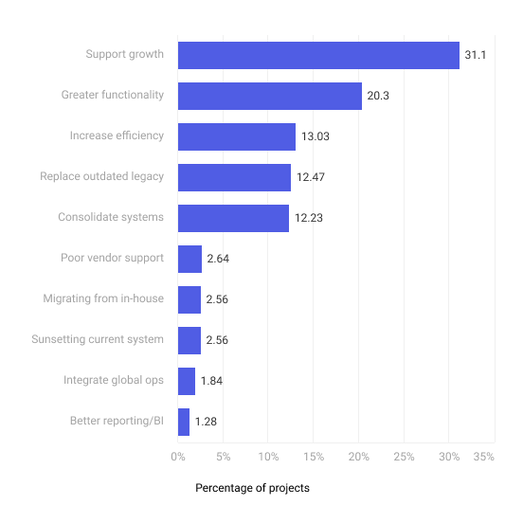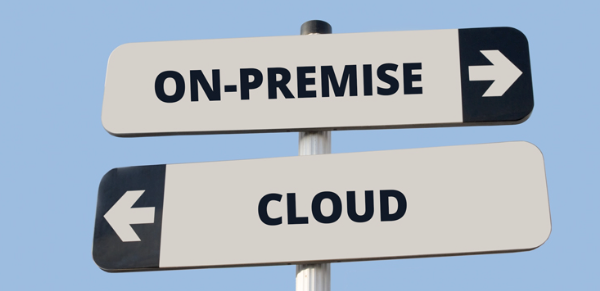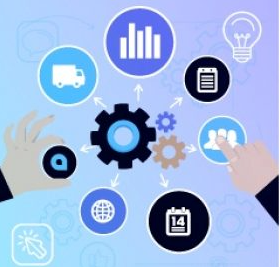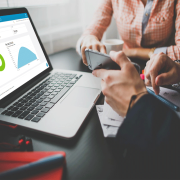Many companies are seriously considering a new ERP system and implementation. Why? A recent survey indicates that over 30% of businesses are doing so as an investment for future growth, while another large percentage are looking for greater functionality and increased efficiency, which are other factors that add to the bottom line.

Advancements in ERP technology give tempting reasons to upgrade. Modern systems are more flexible, easier to customize, and easier to integrate with other key systems your business uses. Anytime, anywhere availability and automation services are factors that move business leaders to consider adopting a cloud solution. And, according to one Gartner report, “By 2023, 65% of organizations will use ERP applications that encompass one or more fourth-era hallmarks”, including being AI-driven and data-centric. These innovations are helping organizations achieve new heights in efficiency and productivity, thus bringing a healthy return on investment.
Implementing new ERP software is no minor undertaking – and no small expense, either. The number one question we get, how much will a new system really cost us?
In a world where ERP project failures and cost overruns are all too common, how can you protect your organization from surprise expenditures along the way? Thorough research, planning, and project management are critical to ensure implementation success. Furthermore, such an organized approach will produce a clearly-defined budget, including all potential extras.
Basic Cost Factors to Consider
Software Path, an industry researcher, recently published its findings about the ERP selection and purchasing process. They stated that “you can expect to spend about $9,000 on each user of your system” over a five-year period, on average. Of course, that can vary depending on what hardware and software you already have in place, and whether you’re looking to do a minor upgrade or a full system replacement.
That figure encompasses more than just licensing fees. Other factors that influence the total project cost are:
- Hardware
- Network infrastructure
- Data conversion
- Implementation and customization services
- Training
- Maintenance
- Ongoing Support
On-Premises or Cloud Deployment?

While there are variations, including a hybrid approach, you will have to decide if you want to host the new ERP solution in the cloud or onsite. What exactly do these terms mean for you?
On-Premises Deployment. In this scenario, the organization pays for the software license up front and has rights to the perpetual use of the system. It also means you must have the necessary hardware installed on-site and managed by your internal IT team. For large organizations, especially those with a strong IT infrastructure already in place, this model could bring the following benefits:
- Cost of ownership is easier to calculate
- One-time purchase
- Cost savings per user over the expected life of the system
- Cost is not tied to usage, so sudden spikes in demand don’t affect your budget
- No upfront hardware costs or in-house IT staff required
- Licensing is billed at a low monthly rate instead of a single large expenditure
- Maintenance, upgrades, backups, and disaster recovery are handled by the vendor
- Flexibility and scalability – You pay for the resources you need at the time, meaning you can grow (or shrink) easily along the way
- Fixed monthly expenditures allow for easy short-term budgeting and increased cash flow
- The system is accessible at anytime and anywhere you have internet access
- Best-in-class data security (better than you can achieve in-house) delivered by the provider
For these and other reasons, 97% of companies are considering a cloud-based ERP solution because of the great number of benefits for SMBs.
Additional Cost Considerations
Going beyond the software itself and the implementation, you’ll want to give attention to these other key areas:
Users or Usage. Many ERP solutions charge per user. Some count these users by each one registered to use it (named users), while others consider how many can be connected to the system at the same time (concurrent users). There are other solution providers, such as Acumatica, that offer unlimited users and instead charge based on transaction volume.
|
In addition to usage fees, Acumatica offers an advanced license option which gives you unlimited users.
*The best way to determine which deployment option and license type is best for you, is to speak with one of our experts. They can help you decide and give you more specific pricing
|

|
Advanced functionality. There are core functions in every ERP that are common business factors for all businesses. However, most ERP solutions offer other modules to address industry specific functions within an organization, such as Project Accounting, Human Resources (HR), Customer Relationship Management (CRM), Business Intelligence (BI), and Supply Chain Management (SCM).
Contractors, manufacturers, distributors, and many other industries will also need to consider special editions of ERP software that attend to the unique needs of each segment. That could include inventory management, BoMs, logistics services, time tracking, and much more.
Integrations and Add-ons. Many businesses have existing business process systems that they don’t want to replace. The cost of integrating the data from those systems with the ERP solution should be included in your budget. However, for those who don’t, or who are open to change, Independent Software Vendors (ISVs) have developed add-on products to supplement the functionality of many popular ERPs. These vendors developed integrations, as opposed to a custom designed one, will be supported through many system upgrades to come. Such add-ons include credit card processing, EDI compliance, sales tax automation, marketing automation, and much more.
Training and Support. One of the biggest impediments to project success is user adoption. When stakeholders don’t understand how the system works, or why the change was needed, their resistance often manifests itself in workarounds, or a reluctance to use the new software at all, which reduces the effectiveness of your investment. Budgeting for initial and ongoing training from your ERP partner is critical to achieving a high user adoption rate.
As you use the system, you will find things that you want to adjust to better fit the way you do business. Or you may encounter problems with the system that didn’t surface during implementation. A monthly service contract with your vendor is another essential expense to ensure you get the most from the time and funds invested.
So How Do I Get Started?
First, download our whitepaper to help you understand the full spectrum of costs and benefits associated with an ERP implementation, as well as calculations needed to determine a true return on your investments.
Second, call 440-498-9920 or contact us here to discuss your business needs and we can help guide you in your options and assist with pricing.




